Current exploration of the process of being heard, work in progress.
Pencil on paper, 120cm x 120cm.
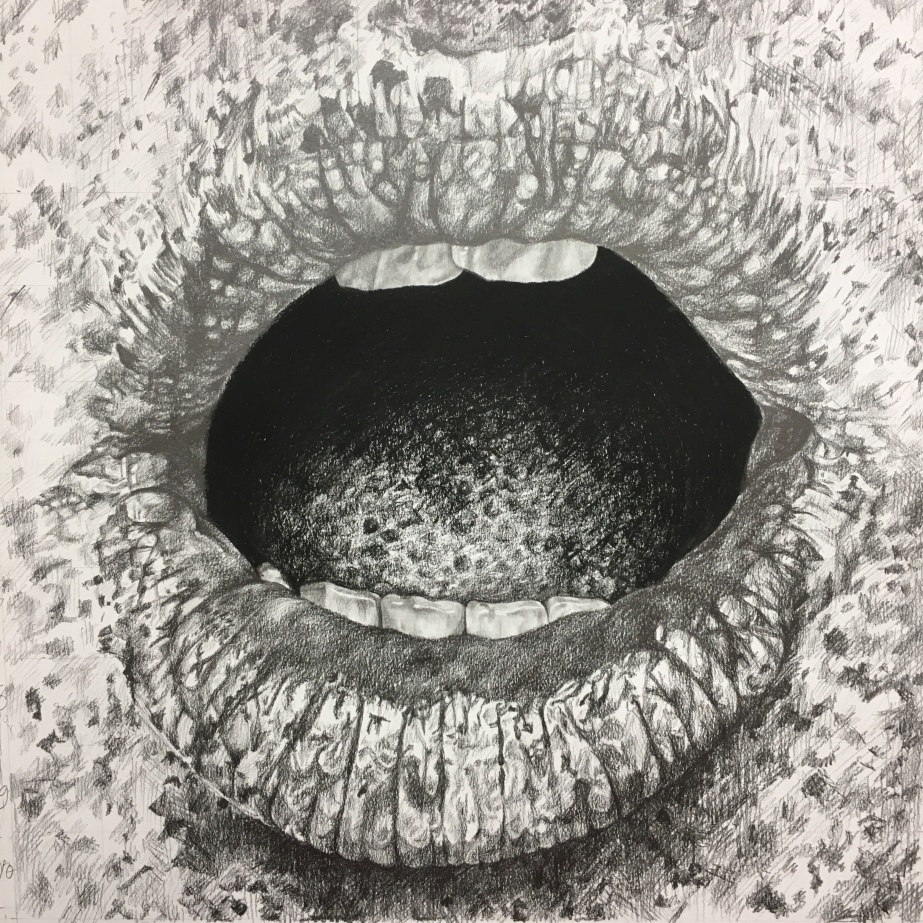
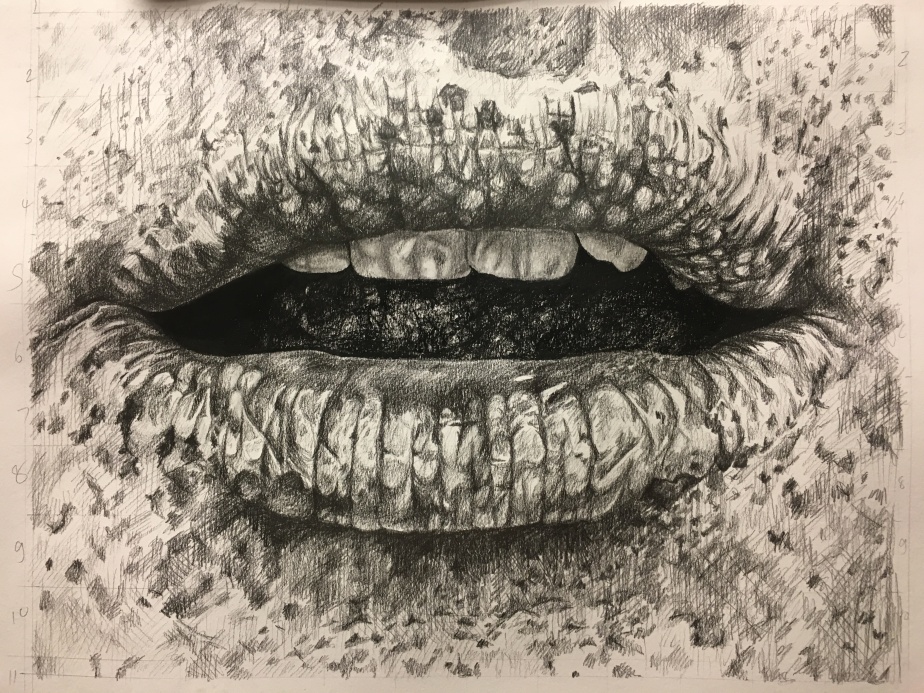
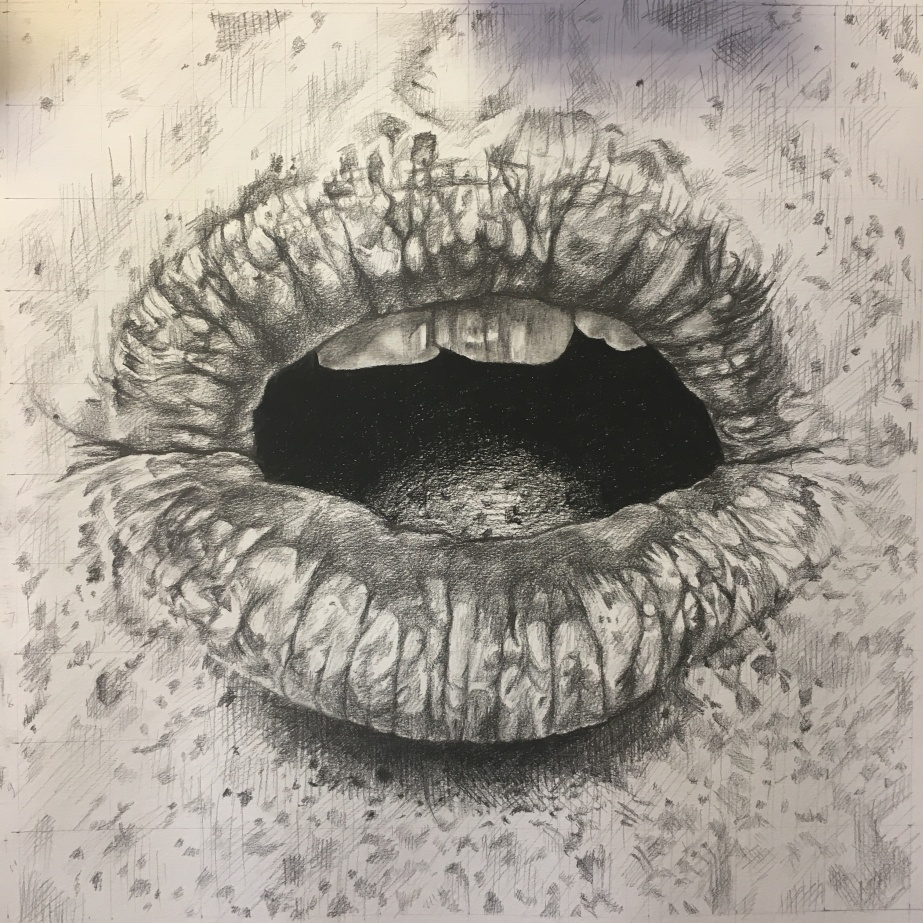
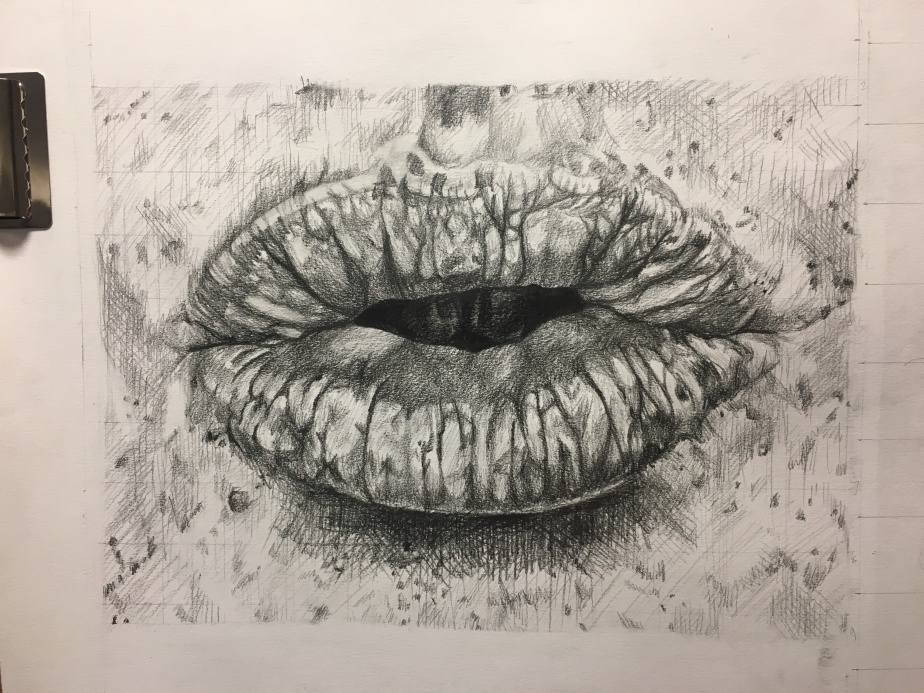
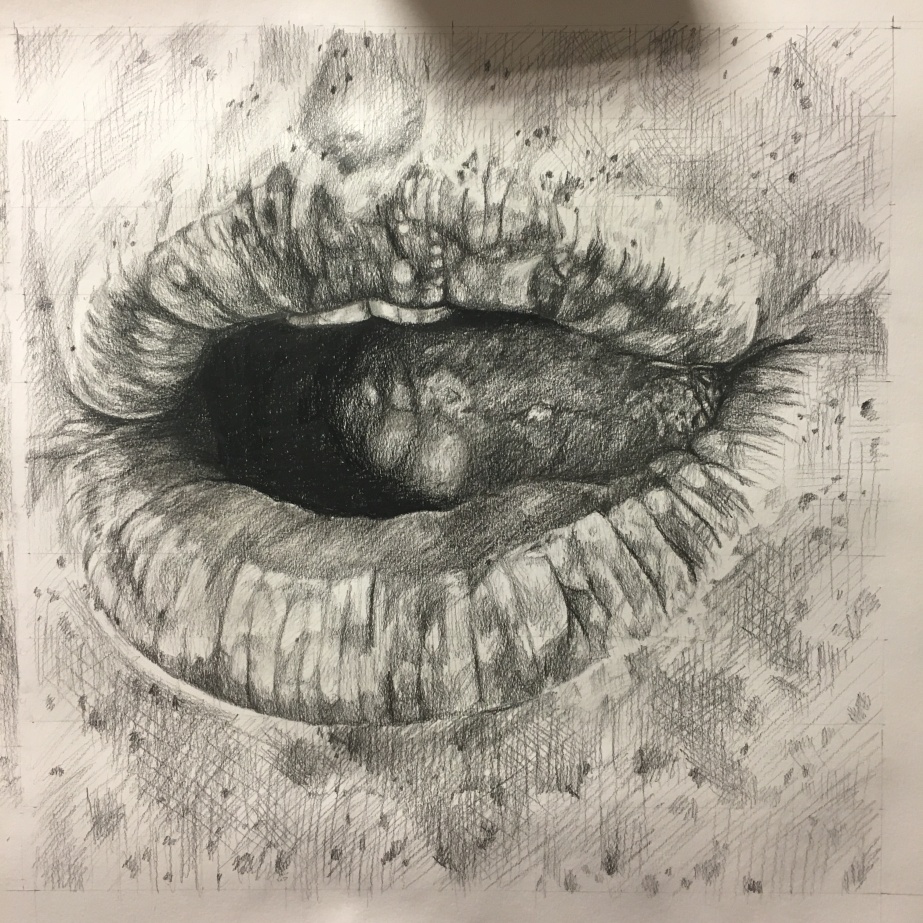
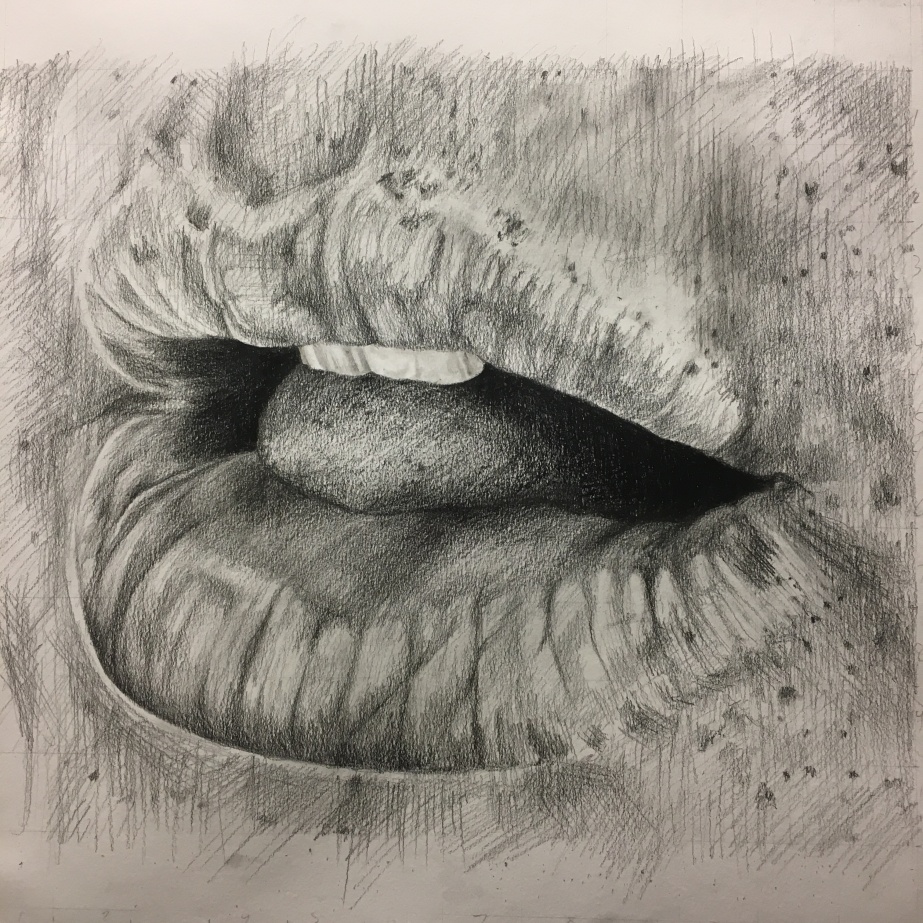
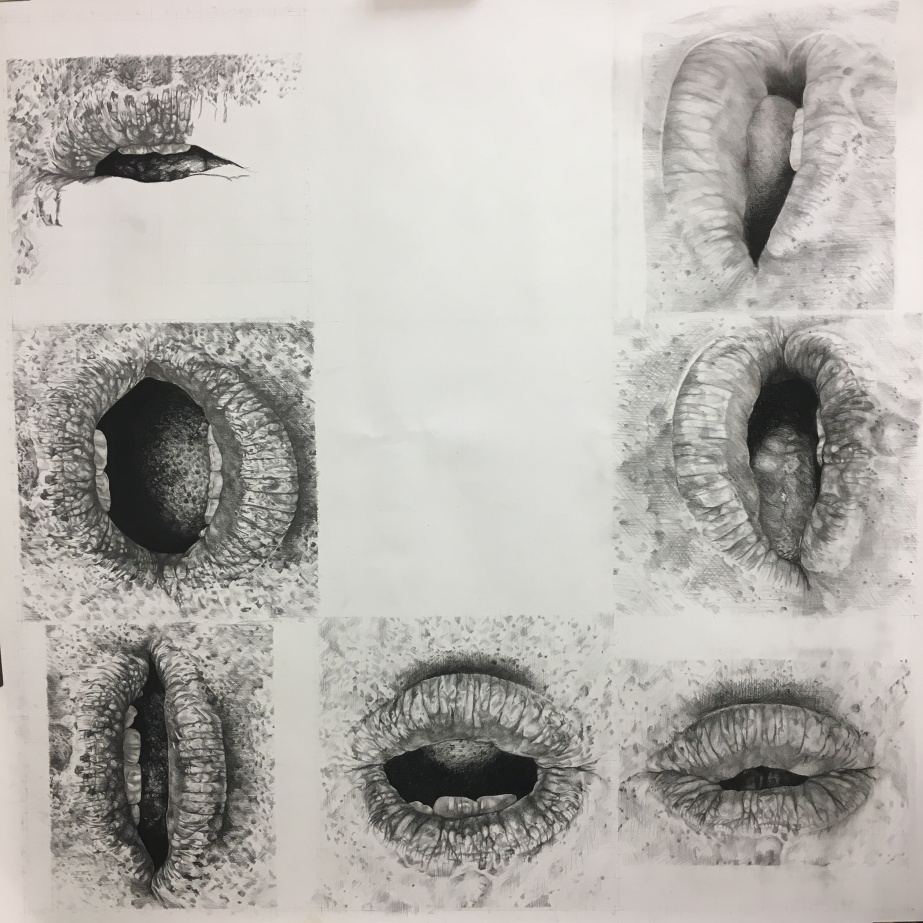
Art and Audience
Current exploration of the process of being heard, work in progress.
Pencil on paper, 120cm x 120cm.







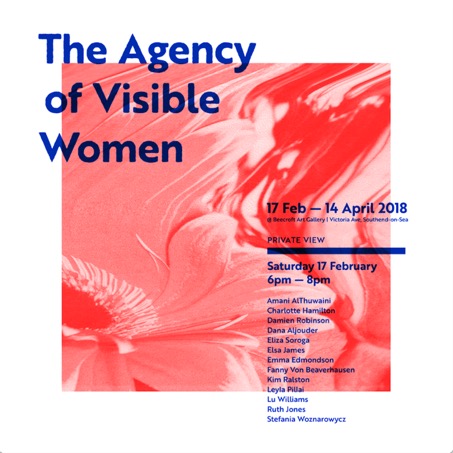
Open Tuesday’s are a continuation of the Agency of Visible Women. I host an open studio for women (trans/femme/nb) artists from Southend on Tuesdays from 12pm – 8pm.
The idea is that women artists can come and share my space, meet one another, collaborate, support one another, network, skills share and have a cuppa.
Since October 2018 every Tuesday has been open to women artists in Southend and attendance has been high. I’m looking forward to seeing who is joining us in 2019 and where the Agency will go from here.
What’s Your Location?
International Research Collective
Crossing the Horizon, 2018
Brazil,
Kuwait,
Australia,
United Kingdom,
United States,
Dear Porto Alegre,
As part of Porto Alegre’s book festival, the WYL? research collective wanted to explore what it means to be an international collective. Pairing each non-Brazilian Artist with a Brazilian artist, we wanted to explore what it means to work collaboratively when the members of our collective are situated in different countries, speaking different languages and producing differing types of work.
Earlier this year WYL? produced a series of films which were screened in the UK. Working through the medium of film gave us a unifying, accessible and economically viable way of working internationally and collectively.
For this exhibition we’ve gone a step further, not just using a unifying medium – in this instance the artists book – but we also wanted to develop collaborative practices between our artists.
We thought carefully about where the books were going to be exhibited and how to make them as accessible as possible. The new artist books published for this exhibition have written information in Portuguese and Arabic to indicate the connections forged between Porto Alegre and Kuwait through the WYL? international research collective.
Centralising Portuguese and Arabic marks a shift in how we want to work. Our intention is not to create works that have no significance to the geographical, social and political context in which they are exhibited, but instead to work with the institutions and people in the locations we produce work for, gaining a deeper understanding of how our artwork has meaning in a local and global context.
Our artists have developed their own working practices as they’ve been paired together. Some have exchanged pages, others have exchanged images, some have argued, resolved their arguments, worked harmoniously. All have worked hard to synthesize two peoples practice into a single vision. The results of which you can see for yourselves.
We hope you find value in the work we’ve made for Porto Alegre and CEEV. We hope you find value in our practice of collaborative working, of experimentation and the collection of different voices from different locations.
Yours Faithfully,
What’s Your Location?
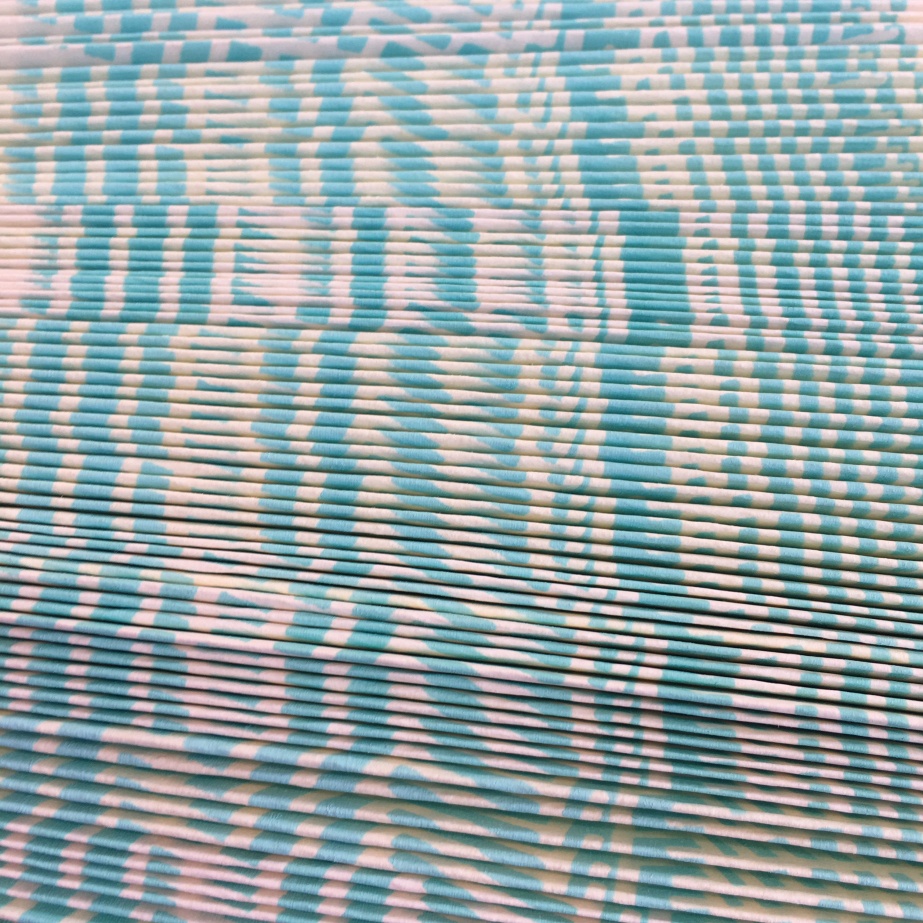
2.00pm to 4.00pm, Focal Point Gallery
Focal Point Gallery is pleased to present a screening of artists films across Big Screen Southend and the temporary cinema space in Gallery One by the international research collective What’s Your Location?
Participating artists include:
Steven Scott
Antonio Da Silva
Gayle Chong Kwan
Frances Young
Katia Salvany
Amana AlThuwaini
Jassim AlNashmi
Rommulo Vieira Conceição
Judy-Ann Moule
Dana AlJouder
Mohamad Hafez
Stefania Woznarowycz
Farah Salem
Presented as part of the public programme for ‘Get Out and Push!’ at Focal Point Gallery.
This event is free and all are welcome.
Below is the text from the accompanying booklet:
What’s Your Location?
Focal Point Gallery
Big Screen Southend
Sunday 8 July 2018
2-4pm
What’s Your Location is an international artist research collective, with a goal to explore how working together can benefit each of its members. WYL? has a core principle of intersectional representation and a commitment to the ongoing development of each artists’ work and using members within the collective to facilitate that goal.
Collectivisation: A Call to Arms for Artists
By Ruth Jones
As we’re practicing now, the stakes are high for us artists.
If you’re genuinely concerned about current political issues that are impacting pretty much every group of people who aren’t cis gendered-heterosexual-white-able bodied-upper middle class-Western-white-men, you aren’t alone.
Against the backdrop of increasing inequality, social division and a backlash against liberal progression, the UK is experiencing something of a creative education crisis.
The working classes and increasingly the mid and lower middle classes are being priced out of university education[i], the arts are being phased out of secondary education[ii], and in primary schools across the country our kids are lucky if they’re allowed 20 minutes off from literacy, numeracy, and arbitrary targets, to get the chance to learn how to use a pair of scissors or mix some paints.
If you couple this with the artworks and artists we have access to in the corporately-funded art institutions of our great nation, you’d be forgiven for believing you stand a snowballs chance in hell at making it in the arts unless you’re the ‘cis-het-white-able bodied-upper middle class-Western-white-man’.
Representation matters. We know this. We’ve seen this. The evidence is everywhere from visitor figures for long awaited exhibitions like “Soul of a Nation”[iii]to the pop culture hits like “Black Panther”[iv]and “Hidden Figures”[v]. If we can see ourselves in those artworks, in those institutions, making that work, curating that exhibition, we can aspire to fulfil those roles.
Of course representation is just part of the battle. In our increasingly disparate state of austerity, where the rich get richer and everyone else gets their publically funded services cut, the arts are being turned to to pick up the shortfall.
If you want to receive any kind of funding[vi]to produce art work, (which let’s face it, you’ll need to because being an artist is prohibitively expensive unless you’re a ‘cis-het-white-able bodied-upper middle class-Western-white-man’), then you’ll need to prove you’re impacting the parts of society that bear the brunt of the public service cuts – namely, everyone who isn’t a ‘cis-het-white-able bodied-upper middle class-Western-white-man’.
It’s quite a bind we’re in as artists. We need to pick up the shortfall for mental health, social and community cohesion, education, accessible culture for all, feeding the poor, saving the children, healing the sick and ending war, and to do that we have to write an extensive, comprehensive and somewhat obscure grant application in competition with every other non ‘cis-het-white-able bodied-upper middle class-Western-white-man’ just to be awarded enough money to pay ourselves less than minimum wage.
So why are we doing it? Well, if we aren’t the wonderfully privileged ‘cis-het-white-able bodied-upper middle class-Western-white-man’, it’s in our interests to make our voices heard. And if you’re in the majority, why not shout? Why not collectivise? Why not work together to share the load and try to force the change?
Why collectivise? We do it so we can get better representation. So those kids whose arts education is rapidly disappearing get to see people like them in the arts, so they can see there’s room for their voices, their success, for them to take up space in the places they’re currently discouraged from inhabiting, that’s why.
And all of this is well and good but we’ve also got a problem in the art “world” in so far as it’s a Euro/Us Western centric “world”. We need to look past our own borders, our own problems and offer solidarity to those artists on the periphery of this “globalised” art economy; the artists whose work isn’t derivative of the Western art vernacular, the artists at the intersects of a global society that problematises non-Western art as naïve and sorts it into a hierarchy with cis-het-white-able bodied-upper middle class-Western-white-man at the top and everyone else at the bottom.
29 years ago Kimberlé Crenshaw coined the term “intersectionality”. It has since been used to help us understand identity politics and more importantly racial and social justice.
If we apply it to help us understand the hierarchy of privilege in the art “world”, then we can see who needs better representation. The more groups “intersect” the less representation they typically have within the arts, and as we all know, REPRESENTATION MATTERS.
Artists at the business end of discrimination in different countries, whose voices are placed further down the hierarchy the more groups they intersect with, should have the same platform of representation as Western artists.
Now, we can get into the argument over whether art and politics should occupy the same space, but if the same group are the dominant voices in a single field, then the representation of that single, privileged, viewpoint becomes a matter of politics. The height of privilege is to be able to ignore the political, because it doesn’t prevent you from living how you’d like, or it doesn’t prevent you from exploring whatever you’d like in your artwork. And when governments and arts organisations are actively encouraging artists and arts institutions to compete for funds to make up the shortfall in public services, then we have a political situation whether we like it or not.
So where does that leave us? If like myself and many of the artists I know, you’re trying to tread the careful line of working to get enough money to live whilst adhering to a set of morals and ethics antithetical to our capitalist society, you’re constantly concerned about how to strengthen not only your position, but also the position of those who don’t share your privilege.
If you’re thinking ethically, if you’re thinking socially, if you’re thinking how to benefit others; you’re mentally placing yourself within a community. If you’re doing that you need like-minded people to work with.
The closer we are on the hierarchy to that privileged position of ‘cis-het-white-able bodied-upper middle class-Western-white-man’ and the more well-meaning and ethically minded we are, the closer we get to thinking of ourselves as “art saviours”. It’s a mindset we have to battle against if we’re actually going to change anything.
Collectivising
The socialist dream of a collective ushering in utopia for the masses is slightly more problematic in a capitalist reality when your collective is full of artists.
Balancing between ideology and practicality is probably your best bet.
Now, if you were lucky enough to go to art school, as a too cool for school and/or hung over to really care student, you probably received a hastily hashed together lecture or module on the importance of networks and contacts that your university were obliged to present you with so they could “evidence” their relevance by providing “well-prepared” workers for the culture industries. As it turns out, that lecture/module was actually pretty important. It’s pretty basic too.
Keep in contact with people, where you see connections that might benefit others – make them, and keep on doing this. Look a little deeper and make a point of nurturing the networks and contacts that are most closely aligned with your personal ethics and morals. Pay attention to personalities, you might share the same ideals as someone but if you find them utterly abhorrent to work with, trust your instincts and avoid them.
Collectives help you to share the load. Leading from the middle, as strange as it sounds, is a way to attract a broader collection of artists, from the more well-known names who lend their reputation and weight to the collective, to the emerging artists who take the weight of organising and administration tasks, to the newly graduated and less experienced artists who want to gain confidence and experience.
Working internationally also provides mutually beneficial experience and exposure to your collective, providing you commit to the principles of representation and why it matters. You can’t just parachute into a country and community that no one has any connection to, and expect that your work should be prioritised over and above the resident artists of that community. Use the expertise and knowledge of the residents of your collective. They’ll know the local environment, the galleries and the arts community in an area. Invite collaborations with more artists from those areas.
Keep a balance between male/female/non binary, artists of colour and white artists, LGBTQIA and heterosexual artists, Western Euro/US and non-colonial artists, diversity of class, age, ability and disability. Let the middle leaders of your collective be the voices of the marginalised, let them lead your ethos and veto artists that don’t commit to your groups ideologies.
Commit to reviewing your working practices and reflect on the work you are producing. Share knowledge and experience, it doesn’t take a minute to share an article, essay, artist with your collective when you can email it over or share it on social media.
Collectives allow you to circumnavigate certain issues that are problematic within arts institutions. If you’re a varied collective you’re already offering them incentives to exhibit your work and hit their targets for diversity and inclusion. You can share the load when writing proposals and funding applications, single artists don’t have that luxury.
Think big, let everyone feed into your goals and ideas for the collective in the short, mid and long term. But this is where things can be problematic. Ideally everyone in your collective will provide a different skill set and an equal amount of labour. Most people’s experience of collectives is not the case. You’ll probably need to have a core group to lead projects forwards. But be open in how you make your decisions so others can learn from your critical decision making. You can’t expect to feed into all of the goals for the collective if you aren’t going to carry your weight in realising those goals. Equally if you’re doing the bulk of the work, you’ll have to make the hard decisions and utilise your time effectively, particularly if you’re providing free labour.
Utilise each other’s skills, for website building, graphic design, writing, social media promotion, funding applications, organisation, talking with other arts professionals/galleries etc. Some may not do any organisational labour, but they’ll build your website. Some might not be great at promoting the collective, but they might be good at planning complex schedules and tracking spending through spreadsheets etc.
When you’re working internationally, you have to work smart. Technology is your friend here. You can work together to curate an online gallery. You can use film to produce an exhibition that can be sent anywhere in the world for next to no cost and be screened online. You can produce creative projects through email, Skype, What’s App, Facebook, Instagram and all the other online platforms. Mail art is a time honoured practice, use it. Crowd-fund, people might want to see your project realised and they’ll pay to help it happen. Research all the ways that you can work together, benefit from one another and produce interesting, new art that holds at its core the voices of many.
There’s no one way to do things, so be generous with your knowledge. Share it with other collectives, share what worked well and what was disastrous or worse, lacklustre.
This is not a definitive guide on to how to collectivise. It’s a call to arms; an argument for collective working practices amongst artists; a way to try to broaden the representation of all groups of artists in an increasingly homogenised art world. It’s a starting point not an end point. Where will you take it from here? Where will we take it from here?
Ruth Jones is an artist and co-curator for international artIst collective ‘What’s Your Location?’, artist in residence for the Essex Feminist Collective and founder of ‘The Agency of Visible Women’. What’s Your Location? is an international research collective, set up by Antonio Da Silva with the help of Ruth Jones, Steven Scott and Jassim AlNashmi in 2014.
Main participating artists in the collective are: Steven Scott, Antonio Da Silva, Gayle Chong Kwan, Frances Young, Katia Salvany, Amani AlThuwaini, Jassim AlNashmi, Rommulo Vieira Conceição, Judy-Ann Moule, Dana AlJouder, Mohamad Hafez, Stefania Woznarowycz, Farah Salem, Ruth Jones, and Amira Behbehani. Affiliated arts professionals include Mercusol Biennale director Gaudencio Fidelis and Kuwaiti Embassy member Mona AlQanai.
WYL? operates in number of countries, chiefly the ones the organizers and artists inhabit: Brazil, Kuwait and the UK. Artists are also resident in the US, Australia and Europe.
WYL? Would like to thank the team at Focal Point Gallery, particularly James Ravinet and Ruth Hazel, and the gallery’s previous director, Joe Hill and the gallery’s interim director, Hayley Dixon.
[i]The first link is to the poverty commission undertaken by the National Union of Students in April 2018 and details key issues that working class students face when attending University: https://www.nus.org.uk/en/news/press-releases/poverty-commission-press-release/The second link from the Guardian in April 2018 contextualizes the impact of poverty on this group of students:
[ii]This link to another Guardian article highlights the reduced uptake of Arts and creative subjects in secondary schools in the UK as of September 2017: https://www.theguardian.com/education/2017/sep/21/proportion-of-students-taking-arts-subjects-falls-to-lowest-level-in-decade
[iii]This link from 2017 postulates that the increase in visitor figures for Tate Modern are based on their diversity in programming in the new Switch House and the commissioning of exhibitions such as The Soul of a Nation: http://www.standard.co.uk/go/london/arts/tate-announces-highest-ever-visitor-numbers-of-84m-as-it-unveils-black-power-blockbuster-a3584716.html%3famp
[iv]A review of box office figures for Black Panther from February 2018 indicates its success: https://www.forbes.com/sites/scottmendelson/2018/02/19/black-panther-all-the-box-office-records-it-broke-and-almost-broke-in-its-242m-debut/#1c1f7e457195
[v]March 2017 article discussing the importance of this film: https://www.forbes.com/sites/scottmendelson/2017/03/16/why-its-a-big-deal-that-hidden-figures-topped-200m-worldwide/#427144b6c914
[vi]The following link leads to an arts council application for under £15k and is a typical example of the length and scope of information artists need to comprehend and comply to in order to receive funding. Applications become more complex the more money is required for a project. https://www.artscouncil.org.uk/sites/default/files/download-file/How_to_apply_guidance_under15k_Project_Grants_24052018_0.pdf
Images and writing have been reproduced with permission of the artists. All writing and images are copyright of the artists.
If you have any queries about WYL? please visit:
http://www.whatsyourlocation.wordpress.com
Dana AlJouder and Bassem Mansour
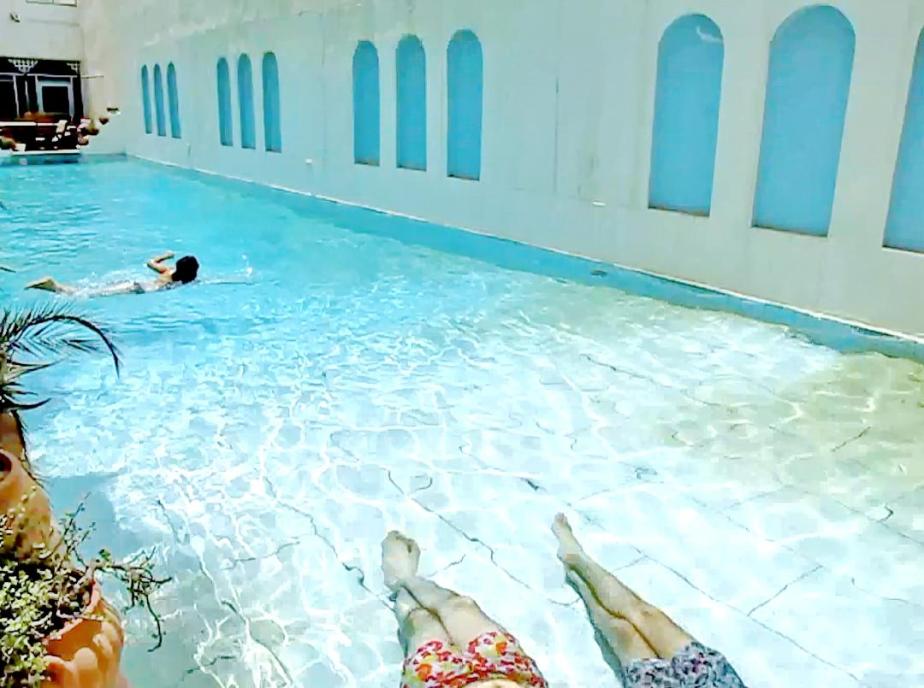
Deportation
Running time: 4:19
Recorded during a shopping trip around town, the deportation story told in detail by a person whom the artist met for the first time is taken to a different location under the sun and by the swimming pool.
Jassim AlNashmi
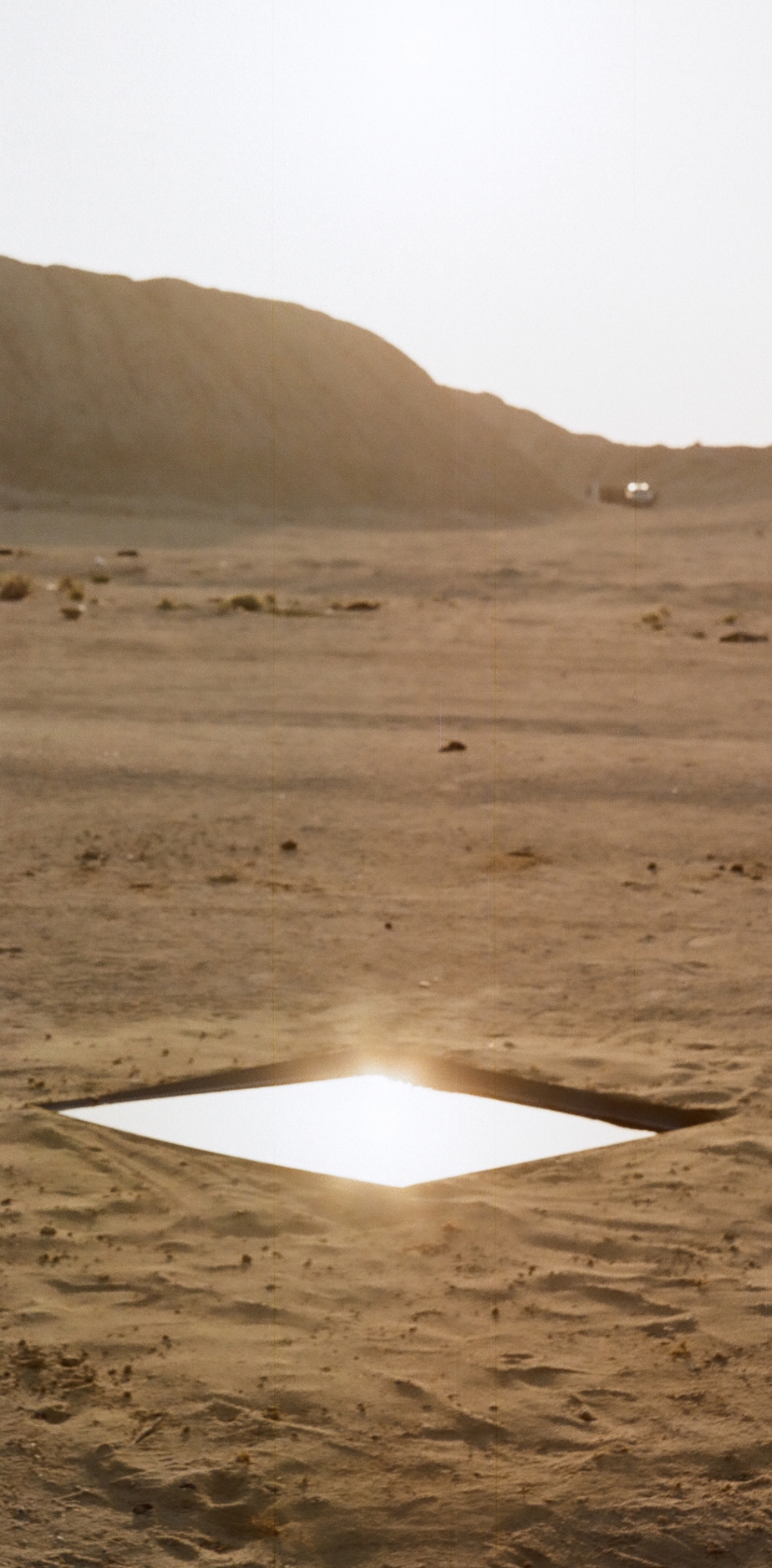
Production of an Oil Memorial
Running time: 2 mins
There are several factors confronting Kuwait’s oil resource, from its depletion, to carbon emissions affecting the ozone layer resulting in climate change, to the global shift of alternate sources of energy consumption. This in turn has an impact on Kuwait’s economy which beckons new modes of income, so Kuwait – as well as other oil-rich countries across the globe – will be less recognized for their oil production and we enter a new era. To mark the end of this era, the empty reservoir memorial reminds us of the industrial revolution and the good and bad that preceded it. The steel cuts the ground next to the oil refineries in Ahmadi and finds there is no natural oil reservoir creating an architectural space of contemplation and marking a new path forward to the holistic city. This film documents the process of this nostalgic longing for the oil era and the challenges in accepting change as Kuwait moves to the new era.
Videography by Mohammed AlNashmi.
Amani AlThuwaini
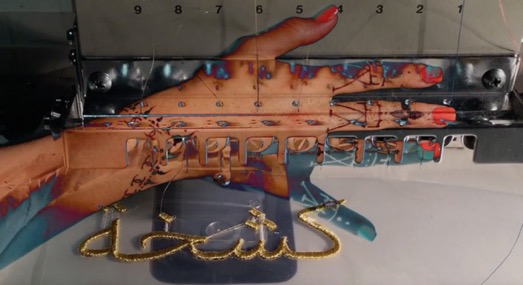
Kashkha
Running time: 28:00
Kashkha is an excessively used word especially in the context of marriage celebrations in The Middle East. Exploring this idea makes me question how marriage is reduced to its material form. Henna in the video is a symbol for wedding traditional ceremonies and the designer logos are a symbol for consumerism. The performance of drawing henna is overlaid with the word kashkha being digitally embroidered. The word kashkha reveals itself at the end of the video and a picture is taken through an iPhone to indicate the transformation of a ceremony to the creation of one’s image in the social circle. This image puts a lot of pressure on women and takes away from the moment of joining two people and two families together through marriage.
Gayle Chong Kwan
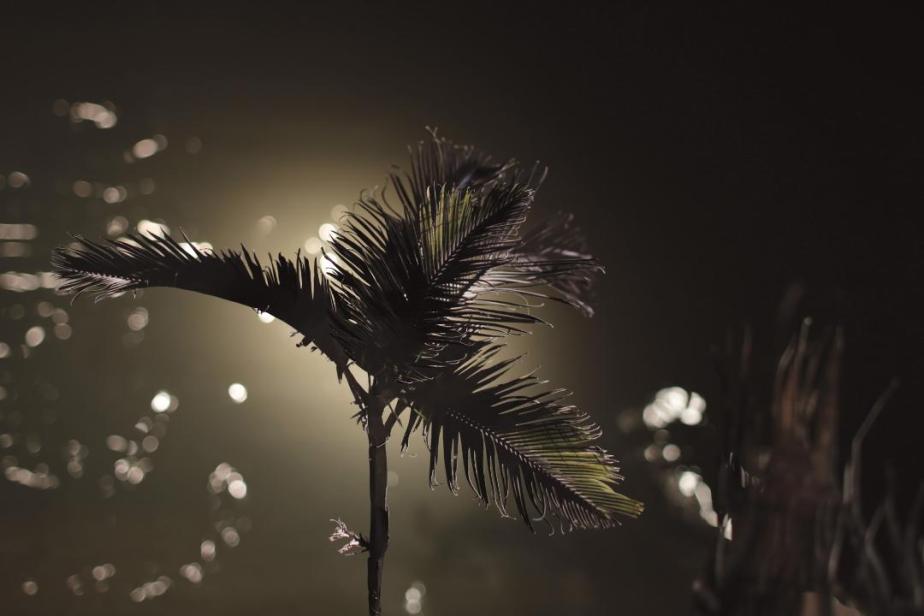
Plot
Running time: 10 mins
From a small parcel of wasteland in Mauritius, owned by her family, ‘Plot’ explores real, constructed and animated landscapes, in search for the sole remaining member of a species of palm at risk of the same fate as that of the island’s Dodo. The work moves between documentary, day and night-time imaginings, simulacrum, the sublime, construction and waste, and ends with a haunting childhood song by the artist’s 99 year old Great Aunt, herself the last of a generation.
Antonio Da Silva
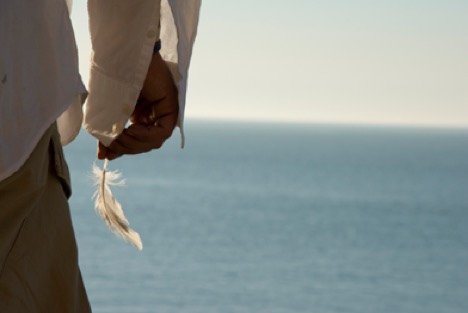
Icarus
Running time: 13:22
This work investigates the presence of isolation in places where past and present coalesce to become part of the same story. Certain aspects of the Icarus story reflect a portrait of the reality today on the island, which was named after him. They are both narratives of escape: the storytelling of a dreamlike fantasy of escape from desolation and despair.
Icarus Island, as it was, is now a barren desert landscape, pockmarked by destroyed and dilapidated buildings. A once thriving environment ravaged by a sudden and cruel war. It is a real and physical depiction of the devastation caused by war and man’s hubris. It contrasts with the nostalgic utopian view of a mythical story from the past. What survives is mostly flora and fauna, which are naturally adapted to this arid environment; scorched by fierce sunlight most of the year. It is nature, and not agriculture, which dominates here. They are the survivors of the war; the human influence is minimal.
A young man is preparing to escape: the flying machine evokes the story of Icarus as he and his father try to escape the tyranny of King Minos. Saddam Hussain’s spectre is omnipresent on Failaka. A utopia destroyed. People fleeing: leaving a pervading sense of isolation.
The flying machine is constructed. The parts are brought up to the top of the building. The young man prepares to fly. The inevitable denouement ensues: the ecstasy of expectation; the delicious tasting of freedom.
Mohamad Hafez
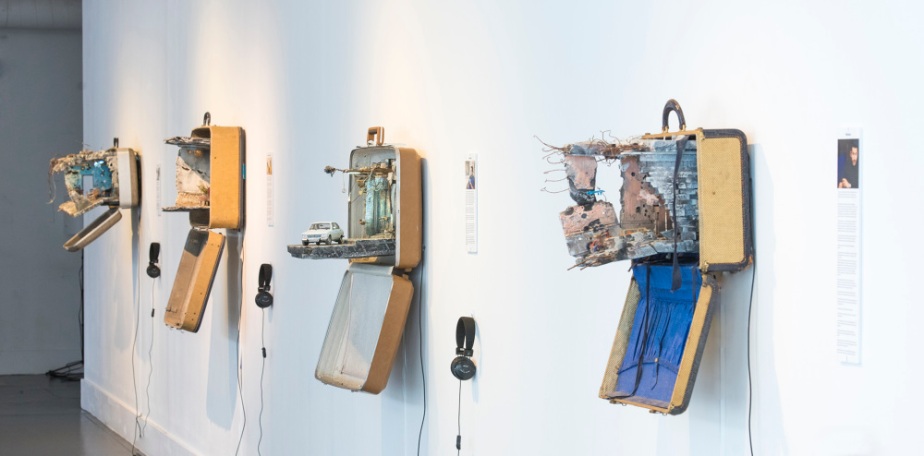
Unpacked Baggage
Running time 13:17
Lost and Found
Running time 0:46
UNPACKED: Refugee Baggage seeks to humanize the word “refugee.” Created during the summer of 2017, this multi-media installation is the work of Syrian-born, New Haven CT artist and architect Mohamad Hafez and Iraqi-born writer and speaker Ahmed Badr.
For UNPACKED: Refugee Baggage Hafez sculpturally re-creates rooms, homes, buildings and landscapes that have suffered the ravages of war. Each is embedded with the voices and stories of real people — from Afghanistan, Congo, Syria, Iraq and Sudan — who have escaped those same rooms and buildings to build a new life in America. Their stories are collected and curated by Badr, who attends Wesleyan University and is himself an Iraqi refugee.
Judy Ann Moule

Map my space
Running time: 7:36
I map my space in feet,
North, south, east, west
90 paces to the corner
Map my space reflects on the relationship between body, place and technology.
The moving image records the artist’s bare feet walking on the path outside her house. The interplay of the rhythmic gait on the textured footpath challenges perceptions of this simple, every-day act as the boundary between body and ground dissolves, and then regains clarity, only to blur again.
Projected onto the screen it engages the viewer sensorially yet creates tension perceptually between vestibular and visual modalities. Everything is unsettled, everything is moving.
Farah Salem
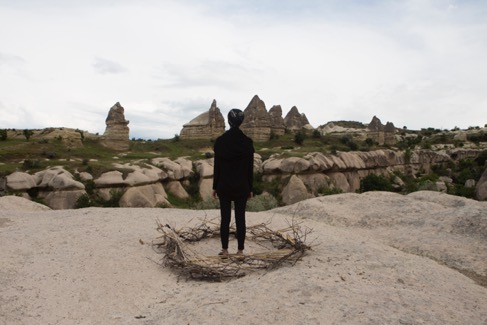
Migration of the Psyche
Running time: 10:40
Many thoughts in every passing minute go through our minds daily. Our entire existence is a collection of thoughts, and we hold the power to select these inner thoughts and bring them into our reality.
This performance begins with sticks being gathered from various locations, just as different thoughts are collected from corners of the human psyche. This is followed by the process of building the nest, or the movement of these elements from one form or location to another. When the nest is near completion a metaphor is made, which is an exploration of the possibilities for thoughts to transform into a physical reality.
The conscious act of building the nest is similar to that required to build our outer world through our inner world. Like birds collecting sticks and from different corners of their environment, we gather and rebuild, taking each piece through a transitional process and, layer by layer, creating new forms. We perform this migration on a daily basis.
Katia Salvany
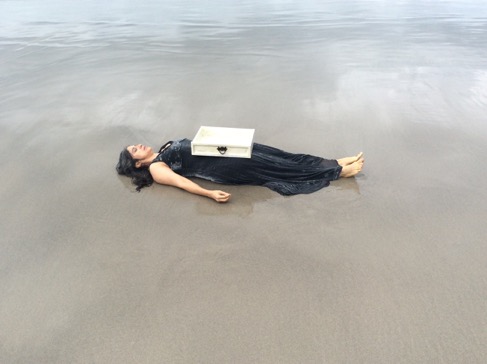
Memento Mori
Running time: 2:46
In Memento Mori the Brazilian artist performs a silent action by the sea-break. Over her body an empty white drawer contrasts with her long black dress, both work as two pieces of an exquisite still life scenario. No human sounds are heard but the constant rumour of the relentless ocean. Here life and death are mingled together as a constant reminder of the power of chance and unpredictability.
Steven Scott
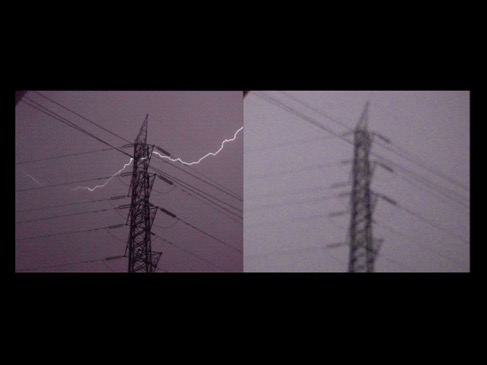
Sequence and Stasis
Running time: 4 mins
This is a short extract from a 35-minute dual projection piece of a tropical thunderstorm shot at night using a low-resolution video camera. At the core of much my work is an examination of difference between two points, in this case between the perception of movement and stasis. As Werner Nekes put it, ‘Cinema is the difference between two frames.’ In Sequence and Stasis I use the random lightening flashes and two screens slipping out of synchronisation to create degrees of difference between points in time and positions in space.
Rommulo Vieira Conceição
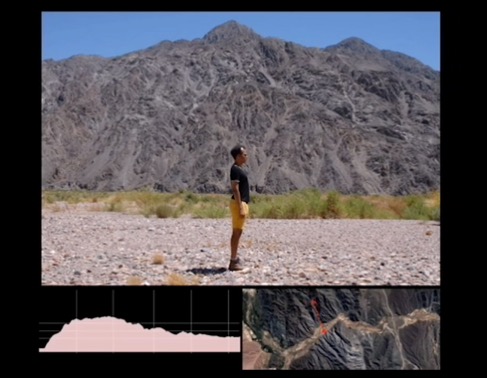
Space becomes place
Running time: 8:08
The work “space becomes place as far as I become familiar with it / 2016-2017” consists of several photos taken as I walk into a landscape in which I have never been before. As I perform this procedure, the space becomes familiar. I begin to situate myself within it, find points of reference that make my location easier, space becomes place, as I appropriate the elements that compose it. With thanks to Rafael Muniz for his assistance with this project.
Stefania Woznarowycz
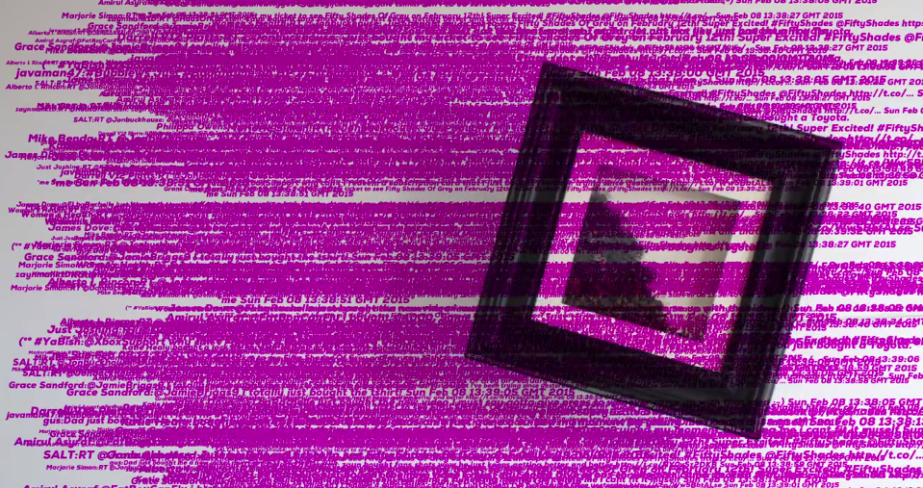
Possessive
Running time: 2:58
Possessive is a study that seeks to document and understand why we establish such profound relationships with certain objects, the euphoria of purchasing a new item and the inevitable anxiety of disposing of the old.
“We attribute to an object a quality that, in reality, does not derive from it, but from our cultural repertoire and conjecture.” — Rafael Cardoso
The project was conducted using twitter’s API to execute a query that searched for tweets using the hash tag #justbought. Once obtained, the ephemeral tweets, perhaps as unimportant as the objects that were themselves bought, were materialised by laser cutting the text into plywood.
The result of this process of materialisation was tangible in shape but intangible in meaning, a pile of illegible letters; thus, by materialising the fleeting moment, the act of senseless consumerism, we void its meaning.
Frances Young
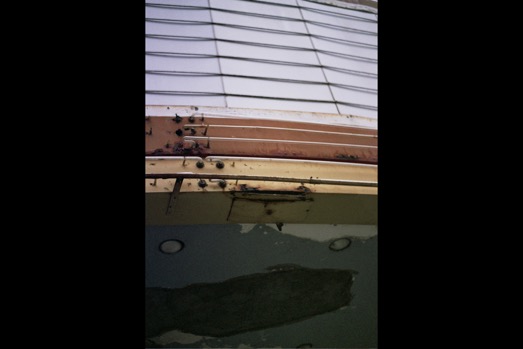
Rise and Fall
Running time: 2:33
Made from 35mm photographs, archive images, super 8 film and DV footage: a fast-paced, fragmentary record of derelict movie theatres in San Francisco.
From the project “Forever is Over Again”, a group of video works and digital prints created in response to locations around the San Francisco Bay area, supported by Arts Council England and Kala Art Institute (Berkeley, CA, USA).
Camera, editing, post-production and sound: Frances Young. Archive images with kind permission from San Francisco History Center, San Francisco Library.
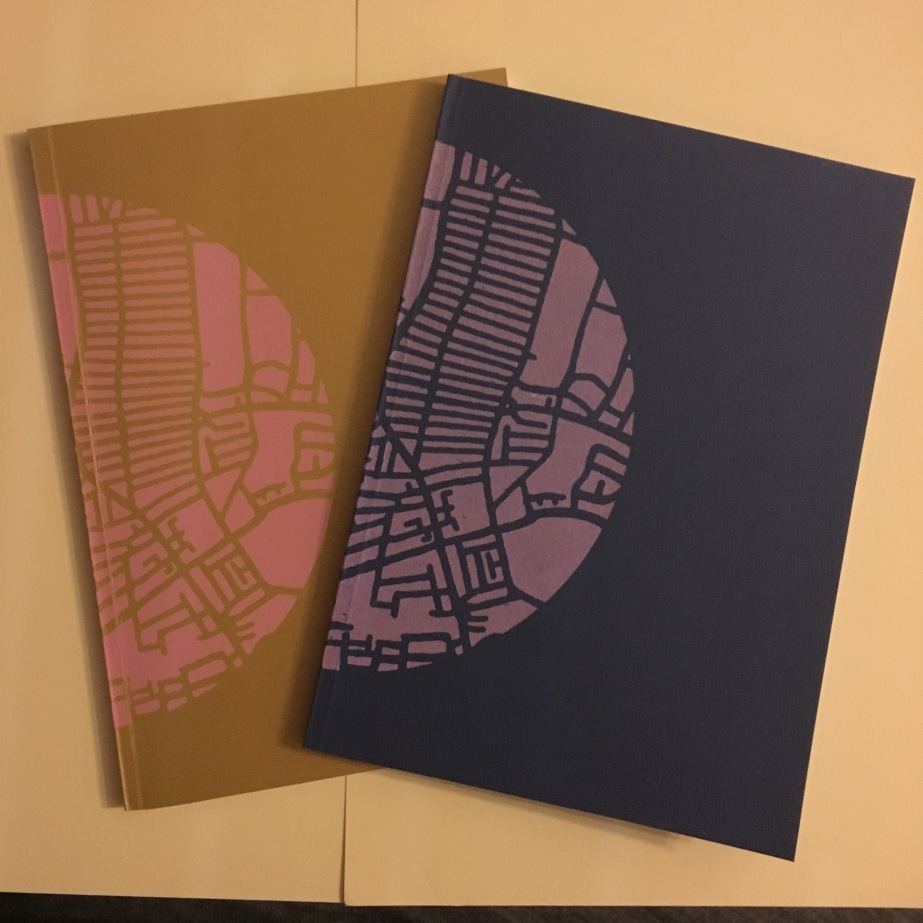
An Experimental Manifesto of Visibility for Women is a limited edition of 15 handmade artist books that outline three main ideas about how every women and femme can take their space, share their space with one another and take care of themselves. Each edition contains different artworks that the artist has used to experiment with how space can be taken, saved and used by women.
The images that follow outline the content of each of the sections Taking Space; Sharing Space and Taking Care. You are free to share this information, provided you credit my work. The works below do not contain the individual art work content.
Ruth Jones, An Experimental Manifesto of Visibility for Women, ‘Taking Space’, February 2018. Copyright the artist.
The second part concerns Sharing Space
Ruth Jones, An Experimental Manifesto of Visibility for Women, ‘Sharing Space’, February 2018. Copyright the artist.
The third part concerns Taking Care.
Ruth Jones, An Experimental Manifesto of Visibility for Women, ‘Taking Care’, February 2018. Copyright the artist.










Ruth Jones, Taking Space: interferences and redactions, 2018
Jones explores the tensions of visibility and space-taking that women experience through two pieces of work developed especially for The Agency of Visible Women.
Taking Space: interferences and redactions addresses the ephemeral nature of claiming and inhabiting space as a women through a gradual redaction of image into nothingness and the reactive, plastic nature of the materials used.










The Agency of Visible Women
The Agency of Visible Women is a fictional institution made flesh for the period 17 February to 14 April 2018 at Beecroft Art Gallery, Southend.
At the Agency of Visible Women we aim to explore the ways that we can address Women’s concerns for their visibility even within the intersects of our feminist communities.
We carry out important work at the Agency and our members represent the breadth of our expertise through their extensive department roles.
You may find your first point of contact at the Agency will be with our Human Resources Officer, Fanny Von Beaverhausen. During office hours Fanny can discuss your concerns about your visibility as a woman or femme. Out of hours you are welcome to relax in Fanny’s office as you watch Agency approved infomercial ‘Blips and Lips’.
Should your interests lie in Public Relations, Amani AlThuwaini’s work addresses public misconceptions about the agency of Middle Eastern Women through the medium of traditional embroidery and poetry.
If you’re concerned about more down to earth things (literally), you can head to our Highways and Maintenance Officer Lu Williams to examine her proposed solutions for public highway drainage in her series of exquisite (wo)manhole covers.
Or perhaps you’d like to View Eliza Soroga’s proposal for effective Pedestrian Management in her collaboration with B Hanusova in the short film entitled ‘Breakfast’?
Alternatively our Assistant Architect Dana AlJouder can lead you on a haunting tour through Singapore’s high rise development HDB, where she brings the functional and monotonous to life with her presence.
In our online resource department you’ll find our Data Analyst Damien Robinson. Here Damien calculates the unpaid labour that women perform and produces beautiful visualisations based on that analysis of data.
Overseeing the online presence of women falls under the remit of Digital Content Curator, Stefania Woznarowycz. Woznarowycz works hard to challenge the male centric view of women through careful digital corruption of stereotypical imagery of women online.
Hard at work in the public eye, Cultural Advisor Elsa James addresses a televised reply to Ron Liddle’s infamous claim that the African Caribbean communities in London possess no culture but violence, goat curry and rap music.
Perhaps you’re finding yourself a little tired after visiting all these departments. ‘Pause’ and replenish yourself with Emma Edmondson the Agency’s favourite Tea Lady, where making is a way to disengage from the catastrophic world events that take place around us.
After your break you can take a stroll over to our Botanist Leyla Pillai. Here you can examine Pillai’s research specimens in close detail.
From here you might like to pay a visit to Hygiene Facilitator Charlotte Hamilton, where frivolous self care and social media get cleaned up with these large scale bath bomb portraits. They’re scented, too!
The serious matters of childcare and motherhood can be sensitively explored with our Parent/Teacher Associate Kim Ralston. She puts her craft skills to good use to understand the problems of motherhood and it’s impact on women’s bodies.
If you’ve the time for a stop with our caretaker Ruth Jones, you can examine how to take space, share space and take care as a woman.
And don’t forget to exit through the gift shop, where you can find Agency made paraphernalia to help you be more visible as a woman.
The Agency of Visible Women takes its role in the community seriously and has partnered up with the non-fictional charity the Essex Feminist Collective. Any donations made by visitors will go to a zine making workshop for survivors of sexual abuse at Southend-on-Sea Rape Crisis.
The Agency of Visible Women
17 February – 14 April 2018
At Beecroft Art Gallery
Victoria Avenue, Southend on Sea, Essex, SS2 6EX Open Tuesday – Saturday 10am – 5pm
Everything Sings: Maps for a Narrative Atlas by Denis Wood is a book/series of work that satisfies in me a desire for applying arbitrary systems and using found and contrived data to produce a new way of looking at something. In the instance of Everything Sings…that something is a geographical location. The data extrapolated and produced in a series of beautifully organised applications of logic to autobiographical narratives is whimsical, experimental and handled with a lightness of touch.
As a narrative exploration of place it is extremely useful. Particularly for examining ways of moving forward with my obsession with how art can help women occupy visible space. And after I have just considered how claiming that space becomes a form of marking territory and the kind of relationship of responsibility that kind of territorial claim might initiate, it offers insights into how a space can be unpicked autobiographically.
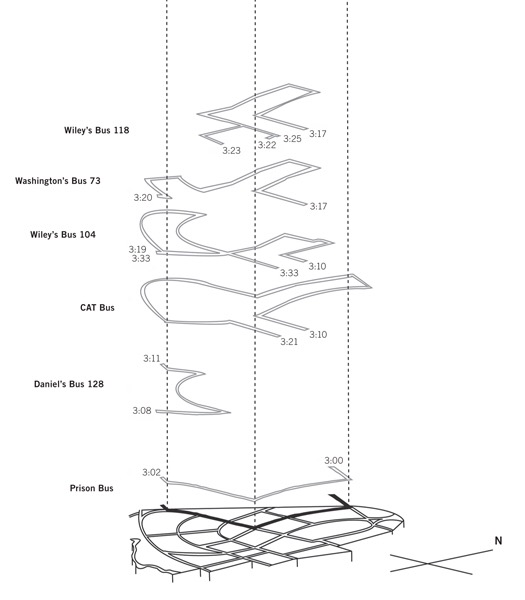
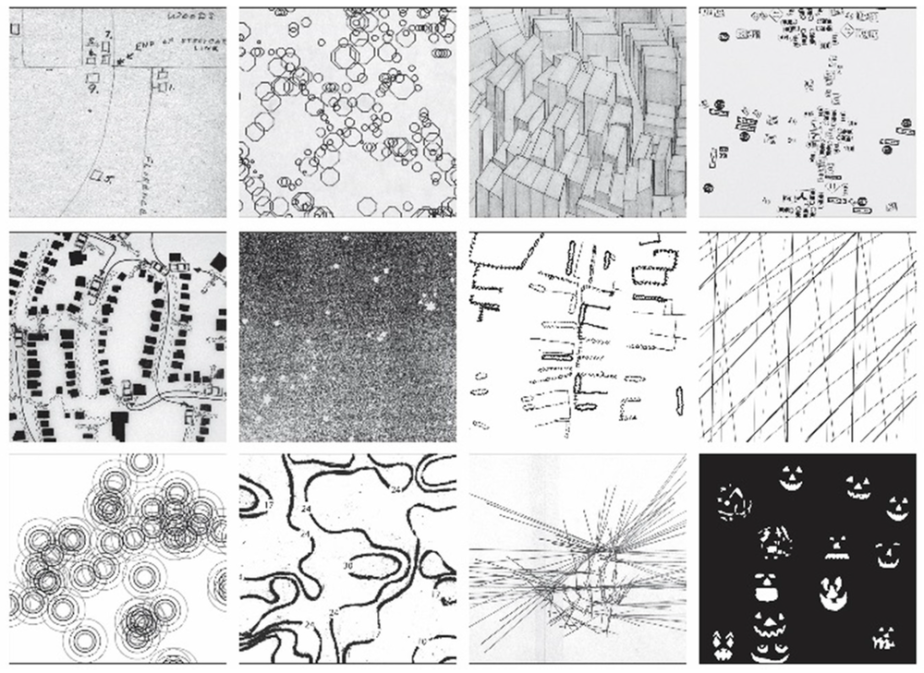
With this in mind I began to think about the psychogeography of where I live. Where is safe? Where would I walk happily on my own during the day? And in turn at night? Can I extrapolate any meaning from the number of sirens I hear per day? Does that mean it’s safer or less safe? Critically examining my relationship to the place I know well could highlight ways to move these experiments forward.
This led to looking at crime statistics for my area. I looked specifically at violence and sexual offences in the belief that that is where a broader range of crime against women might be found. Further research into the statistics available will allow me to unpick this idea a little more.

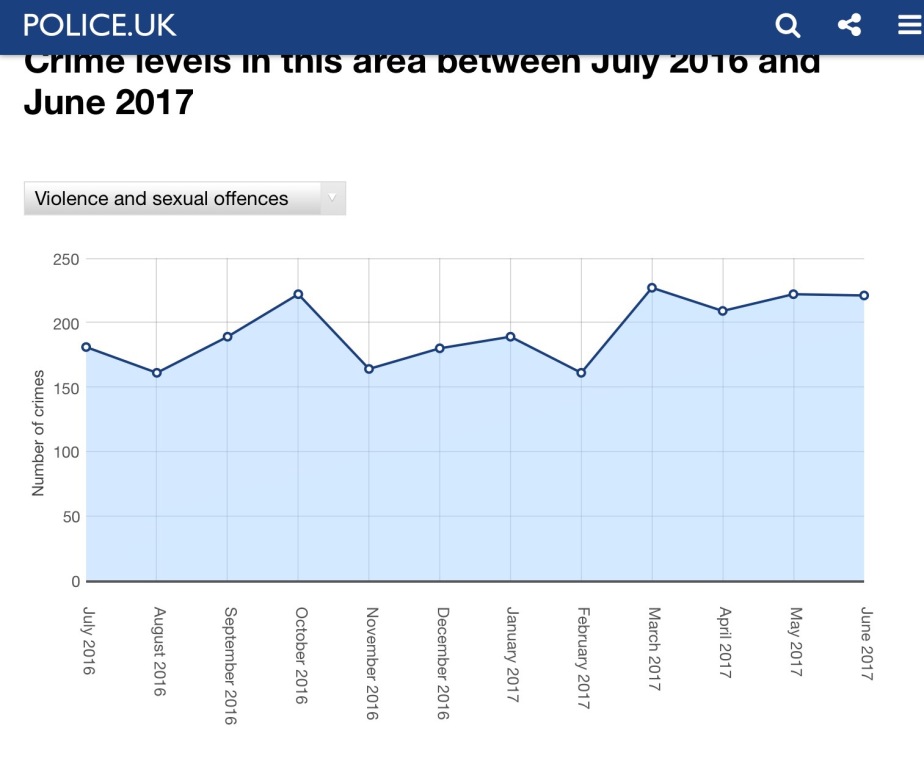
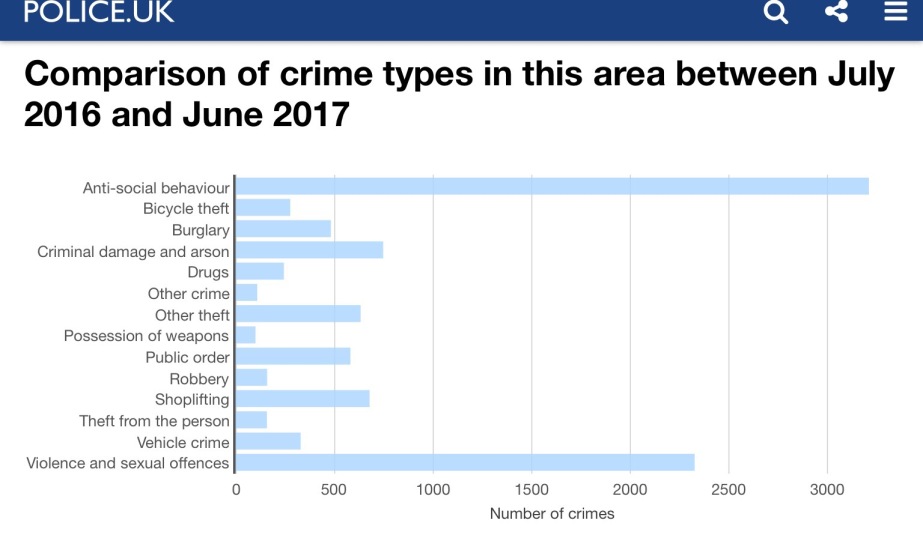
Abigail Reynolds’ Mount Fear (2003), gives physical landscape to statistics and data as it manifests crime in East London. Whilst statistical data will likely be utilised it’s the overlap between that and my own experience of taking space that will I will ultimately want to investigate in more detail. Hopefully examining how they align or separate will create the tensions I’m interested in exploring further, where the main radius of ownership lies and where the overlaps in crime against women occur, perhaps that data will lead to a progression in my work.
Marking territory.
If the subtle marking of a territory can tie you to that area, give you a sense of ownership, what then becomes your responsibility to that area, to your space?
What will become the back and forth outcome? The dialogue between myself and that space? How I take it, leave my proxies (stickered bacterial representations), inhabit it and in turn what will its mark on me be?
Should I take its bacteria? Apply it to images of myself?
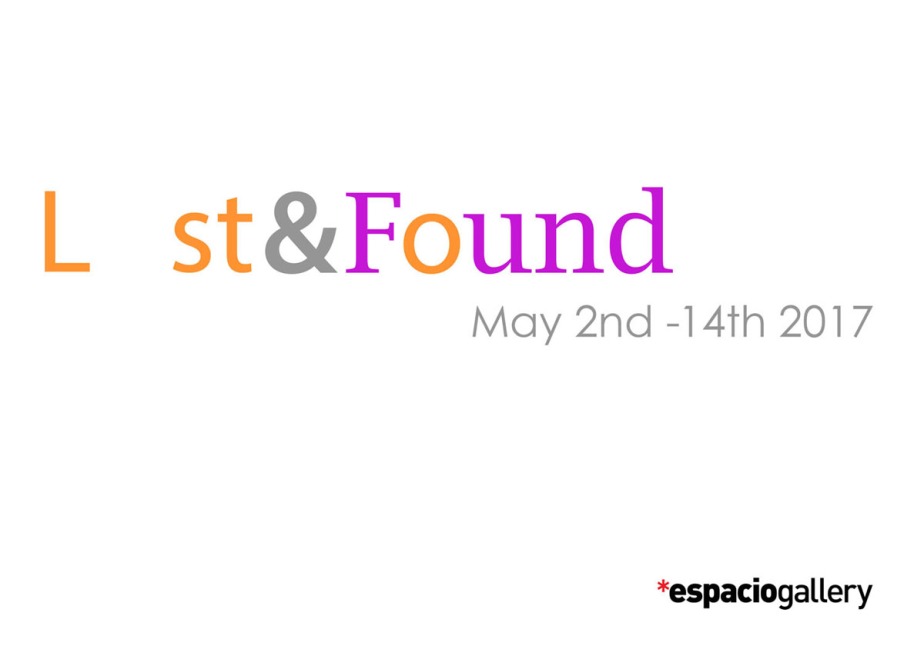
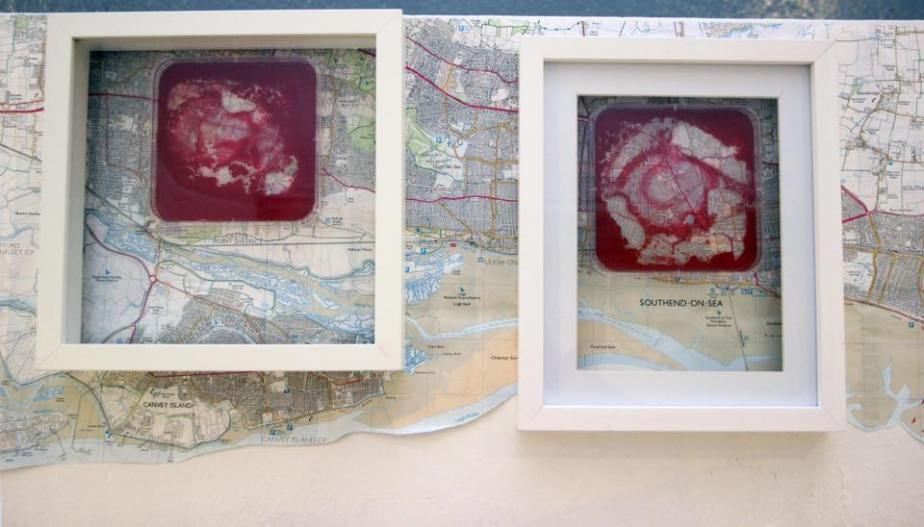
My art practice is based around my obsession with care and the occupation of politically visible space. My focus over the past two years has shifted towards the gendering of both of those subjects and how my practice can interrogate these dual interests without becoming overly documentarian, prescriptive or propagandised. For me, making art is a way of making sense of the world, of critically unpicking the elements that cause tensions.
The nebulous nature of ‘Lost and Found’ has left me with a deep sense of sadness. In order to find something you must first know it is lost, you have to be aware of its absence. The losses I am considering are political and gendered in nature. In specific the loss of identity of women and the loss of access to space. These losses are sharply felt by their absence and I do not know if they can be found again and if they could, I don’t know where or how to find them. Built in to these polar states is a sense of completion, if you could just but find the lost thing, you could be whole again. Some losses can never be found and in that instance you are left incomplete.
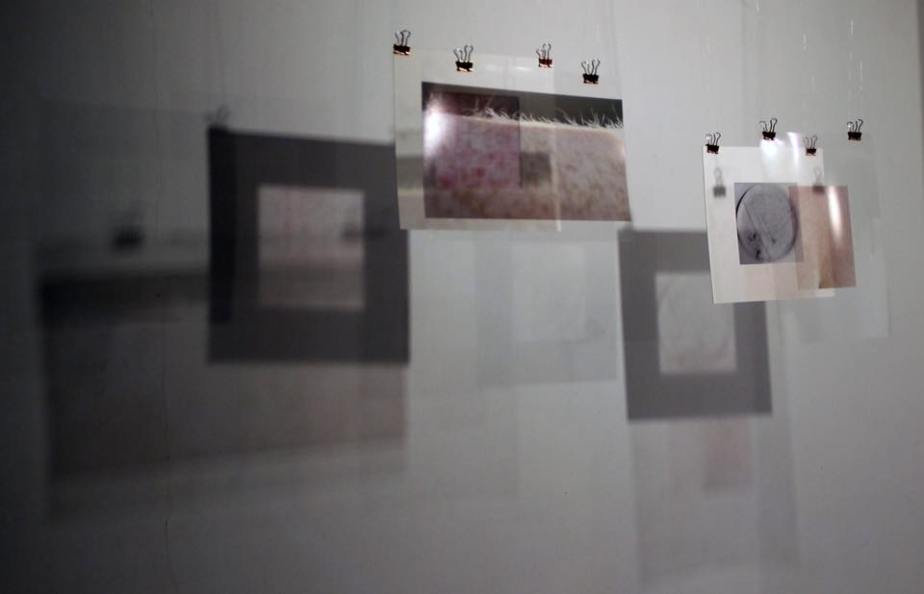
I’m exploring the losses that may not be re-found. Considering in specific how gentrification effectively redacts women’s (and from an intersectional point of view the race, sexuality and class of these women redacts them further) access to public spaces/services in my local area.
Redaction is another key area of interest in this exploration, it is the sanitisation of imagery in specific that I am considering, so it becomes a way of losing part of the image. Is the loss of the visibility (for women in specific) indicative of a loss of identity? Without great effort on behalf of many, how will this be found?